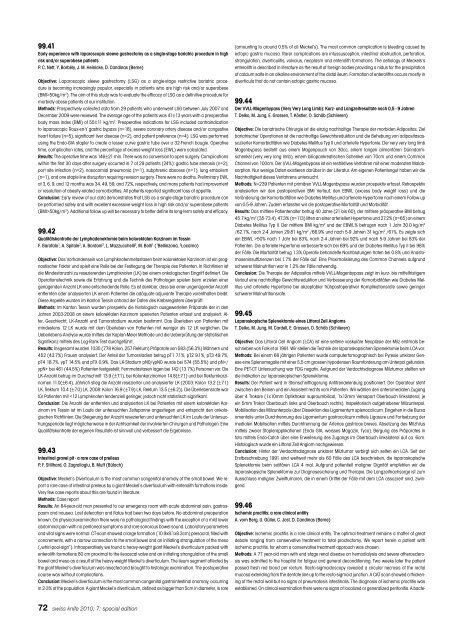Anorectal Manometry in 3D NEW! - Swiss-knife.org
Anorectal Manometry in 3D NEW! - Swiss-knife.org
Anorectal Manometry in 3D NEW! - Swiss-knife.org
Create successful ePaper yourself
Turn your PDF publications into a flip-book with our unique Google optimized e-Paper software.
99.41<br />
Early experience with laparoscopic sleeve gastrectomy as a s<strong>in</strong>gle-stage bariatric procedure <strong>in</strong> high<br />
risk and/or superobese patients<br />
P. C. Nett, Y. Borbély, J. M. He<strong>in</strong>icke, D. Cand<strong>in</strong>as (Berne)<br />
Objective: Laparoscopic sleeve gastrectomy (LSG) as a s<strong>in</strong>gle-stage restrictive bariatric procedure<br />
is becom<strong>in</strong>g <strong>in</strong>creas<strong>in</strong>gly popular, especially <strong>in</strong> patients who are high risk and/or superobese<br />
(BMI>50kg/m 2 ). The aim of this study was to evaluate the efficacy of LSG as a def<strong>in</strong>itive procedure for<br />
morbidly obese patients at our <strong>in</strong>stitution.<br />
Methods: Prospectively collected data from 29 patients who underwent LSG between July 2007 and<br />
December 2009 were reviewed. The average age of the patients was 41±13 years with a preoperative<br />
body mass <strong>in</strong>dex (BMI) of 55±11 kg/m 2 . Preoperative <strong>in</strong>dications for LSG <strong>in</strong>cluded contra<strong>in</strong>dication<br />
to laparoscopic Roux-en-Y gastric bypass (n=18), severe coronary artery disease and/or congestive<br />
heart failure (n=5), significant liver disease (n=2), and patient preference (n=4). LSG was performed<br />
us<strong>in</strong>g the Endo-GIA stapler to create a lesser curve gastric tube over a 32-French bougie. Operative<br />
time, complication rates, and the percentage of excess weight loss (EWL) were calculated.<br />
Results: The operative time was 146±21 m<strong>in</strong>. There was no conversion to open surgery. Complications<br />
with<strong>in</strong> the first 30 days after surgery occurred <strong>in</strong> 7 of 29 patients (24%): gastric tube stenosis (n=2),<br />
port site <strong>in</strong>fection (n=2), nosocomial pneumonia (n=1), subphrenic abscess (n=1), lung embolism<br />
(n=1), and one staple l<strong>in</strong>e disruption requir<strong>in</strong>g revision surgery. There were no deaths. Prelim<strong>in</strong>ary EWL<br />
at 3, 6, 9, and 12 months was 34, 49, 59, and 72%, respectively, and many patients had improvement<br />
or resolution of obesity-related comorbidities. All patients reported significant loss of appetite.<br />
Conclusion: Early review of our data demonstrates that LSG as a s<strong>in</strong>gle-stage bariatric procedure can<br />
be performed safely and with excellent excessive weight loss <strong>in</strong> high risk and/or superobese patients<br />
(BMI>50kg/m 2 ). Additional follow up will be necessary to better def<strong>in</strong>e its long-term safety and efficacy.<br />
99.42<br />
Qualitätskontrolle der Lymphadenektomie beim kolorektalen Karz<strong>in</strong>om im Tess<strong>in</strong><br />
F. Garofalo 1 , A. Spitale 2 , A. Bordoni 2 , L. Mazzucchelli 2 , M. Bolli 1 ( 1 Bell<strong>in</strong>zona, 2 Locarno)<br />
Objective: Das Vorhandense<strong>in</strong> von Lymphknotenmetastasen beim kolorektalen Karz<strong>in</strong>om ist e<strong>in</strong> prognostischer<br />
Faktor und spielt e<strong>in</strong>e Rolle bei der Festlegung der Therapie des Patienten. In Richtl<strong>in</strong>ien ist<br />
die M<strong>in</strong>destanzahl zu resezierenden Lymphknoten (LK) bei e<strong>in</strong>em onkologischen E<strong>in</strong>griff def<strong>in</strong>iert. Die<br />
Operationstechnik sowie die Erfahrung und die Technik des Pathologen spielen beim erzielen e<strong>in</strong>er<br />
genügenden Anzahl LK e<strong>in</strong>e entscheidende Rolle. Es ist denkbar, dass bei e<strong>in</strong>er ungenügender Anzahl<br />
entfernten oder analysierten LK e<strong>in</strong>em Patienten die adäquate adjuvante Therapie vorenthalten bleibt.<br />
Diese Aspekte wurden im Kanton Tess<strong>in</strong> anhand der Daten des Krebsregisters überprüft.<br />
Methods: Im Kanton Tess<strong>in</strong> wurden prospektiv die histologisch ausgewerteten Präparate der <strong>in</strong> den<br />
Jahren 2003-2008 an e<strong>in</strong>em kolorektalen Karz<strong>in</strong>om operierten Patienten erfasst und analysiert. Alter,<br />
Geschlecht, LK-Anzahl und Tumorstadium wurden bestimmt. Das Überleben von Patienten mit<br />
m<strong>in</strong>destens 12 LK wurde mit dem Überleben von Patienten mit weniger als 12 LK verglichen. Die<br />
Ueberlebens-Analyse wurde mittels der Kaplan-Meier Methode und die Ueberprüfung der statistischen<br />
Signifikanz mittels des Log-Rank Test durchgeführt.<br />
Results: Insgesamt wurden 1035 (778 Kolon, 257 Rektum) Präparate von 583 (56.3%) Männern und<br />
452 (43.7%) Frauen analysiert. Der Anteil der Tumorstadien betrug pT1 7.1%, pT2 9.1%, pT3 49.7%,<br />
pT4 18.7%, ypT 14.5% und pTX 0.9%. Das LK-Stadium pN0/ypN0 wurde bei 574 (55.5%) und pN+/<br />
ypN+ bei 461 (44.5%) Patienten festgestellt, Fernmetastasen lagen bei 142 (13.7%) Personen vor. Die<br />
LK-Anzahl betrug im Durchschnitt 13.9 (±7.1), bei Kolonkarz<strong>in</strong>omen 14.8(±7.1) und bei Rektumkarz<strong>in</strong>omen<br />
11.0(±6.4). Jährlich stieg die Anzahl resezierter und analysierter LK (2003: Kolon 13.2 (±7.1)<br />
LK, Rektum 10.4 (±7.0) LK, 2008: Kolon 16.9 (±7.9) LK, Rektum 13.5 (±6.2)). Die Überlebensrate war<br />
für Patienten mit 50% nach 1 Jahr bei 83%, nach 2-4 Jahren bei 92% und nach 5-9 Jahren bei 83% der<br />
Patienten. Die arterielle Hypertonie verbesserte sich bei 69% und der Diabetes Mellitus Typ II bei 98%<br />
der Fälle. Die Mortalität betrug 1.3%.Operativ behandelte Nachblutungen traten bei 0.8% und Anastomosen<strong>in</strong>suffizienzen<br />
bei 1.7% der Fälle auf. E<strong>in</strong>e Proximalisierung des Common Channels aufgrund<br />
schwerer Malnutrition war <strong>in</strong> 1.2% der Fälle notwendig.<br />
Conclusion: Die Therapie der Adipositas mittels VVLL-Magenbypass zeigt im kurz- bis mittelfristigem<br />
Verlauf e<strong>in</strong>e nachhaltige Gewichtsreduktion und Verbesserung der Komorbiditäten wie Diabetes Mellitus<br />
und arterielle Hypertonie bei akzeptabler frühpostoperativer Komplikationsrate sowie ger<strong>in</strong>ger<br />
schwerer Malnutritionsrate.<br />
99.45<br />
Laparoskopische Splenektomie e<strong>in</strong>es Littoral Zell Angioms<br />
T. Delko, M. Jung, M. Cardell, E. Grossen, O. Schöb (Schlieren)<br />
Objective: Das Littoral Cell Angiom (LCA) ist e<strong>in</strong>e seltene vaskuläre Neoplasie der Milz erstmals beschrieben<br />
von Falk et al 1991. Wir stellen die Technik der laparoskopsichen Splenektomie beim LCA vor.<br />
Methods: Bei e<strong>in</strong>em 66 jährigen Patienten wurde computertomographisch bei Pyrexie unklarer Genese<br />
e<strong>in</strong>e Splenomegalie mit e<strong>in</strong>er 5,5 cm grossen hypodensen Raumforderung am Unterpol gefunden.<br />
E<strong>in</strong>e PET-CT Untersuchung war FDG negativ. Aufgrund der Verdachtsdiagnose Milztumor stellten wir<br />
die Indikation zur laparoskopischen Splenektomie.<br />
Results: Der Patient wird <strong>in</strong> Ste<strong>in</strong>schnittlagerung Antitrendelenburg positioniert. Der Operateur steht<br />
zwischen den Be<strong>in</strong>en und e<strong>in</strong> Assistent rechts vom Patienten. Wir wählen den anteromedialen Zugang<br />
über 4 Trokare (1x10mm Optiktrokar supraumbilical, 1x12mm Versaport Oberbauch l<strong>in</strong>kslateral, je<br />
e<strong>in</strong> 5mm Trokar Oberbauch l<strong>in</strong>ks und Oberbauch rechts). Inspektorisch aufgetriebener Milzunterpol.<br />
Mobilisation des Milzunterpols über Dissektion des Ligamentum splenocolicum. E<strong>in</strong>gehen <strong>in</strong> die Bursa<br />
omentalis unter Durchtrennung des Ligamentum gastrocolicum mittels Ligasure und Fortsetzung der<br />
medialen Mobilisation mittels Durchtrennung der Arteriae gastricae breves. Absetzung des Milzhilus<br />
mittels zweier Staplerapplikationen (Endo GIA, weisses Magaz<strong>in</strong>, Tyco). Bergung des Präparates <strong>in</strong><br />
toto mittels Endo-Catch über e<strong>in</strong>e Erweiterung des Zugangs im Oberbauch l<strong>in</strong>kslateral auf ca. 6cm.<br />
Histologisch wurde e<strong>in</strong> Littoral Zell Angiom nachgewiesen.<br />
Conclusion: H<strong>in</strong>ter der Verdachtsdiagnose unklarer Milztumor verbirgt sich selten e<strong>in</strong> LCA. Seit der<br />
Erstbeschreibung 1991 s<strong>in</strong>d weltweit mehr als 60 Fälle des LCA beschrieben, die laparoskopische<br />
Splenektomie beim solitären LCA 4 mal. Aufgrund potientiell maligner Dignität empfehlen wir die<br />
laparoskopsiche Splenektomie zur Diagnosesicherung und Therapie. Die Langzeitnachs<strong>org</strong>e ist zum<br />
Ausschluss maligner Zweittumoren, die <strong>in</strong> e<strong>in</strong>em Drittel der Fälle mit dem LCA assoziiert s<strong>in</strong>d, zw<strong>in</strong>gend.<br />
99.46<br />
Ischemic proctitis: a rare cl<strong>in</strong>ical entitiy<br />
A. vom Berg, U. Güller, C. Jost, D. Cand<strong>in</strong>as (Berne)<br />
Objective: Ischemic proctitis is a rare cl<strong>in</strong>ical entity. The optimal treatment rema<strong>in</strong>s a matter of great<br />
debate rang<strong>in</strong>g from conservative treatment to total proctectomy. We report here<strong>in</strong> a patient with<br />
ischemic proctitis, for whom a conservative treatment approach was chosen.<br />
Methods: A 77 year-old man with end stage renal disease on hemodialysis and severe atherosclerosis<br />
was admitted to the hospital for fatigue and general decondition<strong>in</strong>g. Two weeks later the patient<br />
passed fresh red blood per rectum. Recto-sigmoidoscopy revealed a circular necrosis of the rectal<br />
mucosa extend<strong>in</strong>g from the dentate l<strong>in</strong>e up to the recto-sigmoid junction. A CAT scan showed a thicken<strong>in</strong>g<br />
of the rectal wall but no signs of pneumatosis <strong>in</strong>test<strong>in</strong>alis. The diagnosis of ischemic proctitis was<br />
established. On cl<strong>in</strong>ical exam<strong>in</strong>ation there were no signs of localized or generalized peritonitis. A bacte-
















